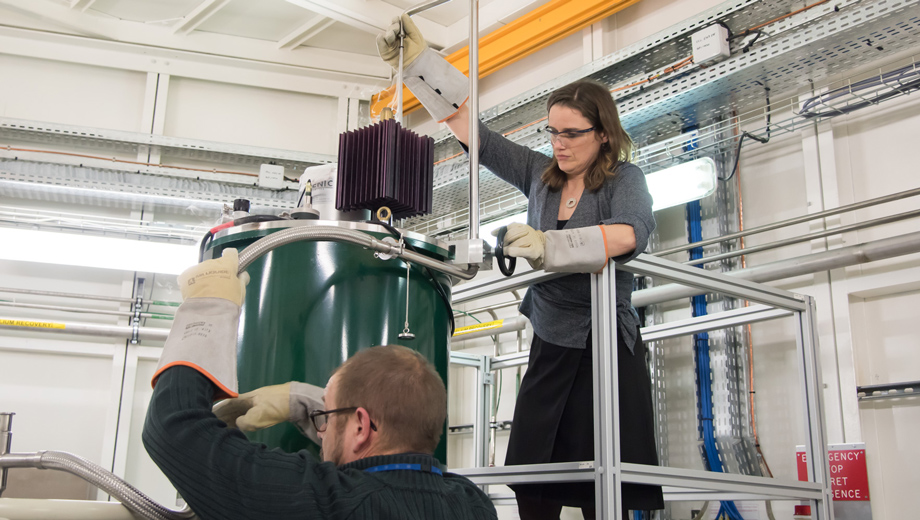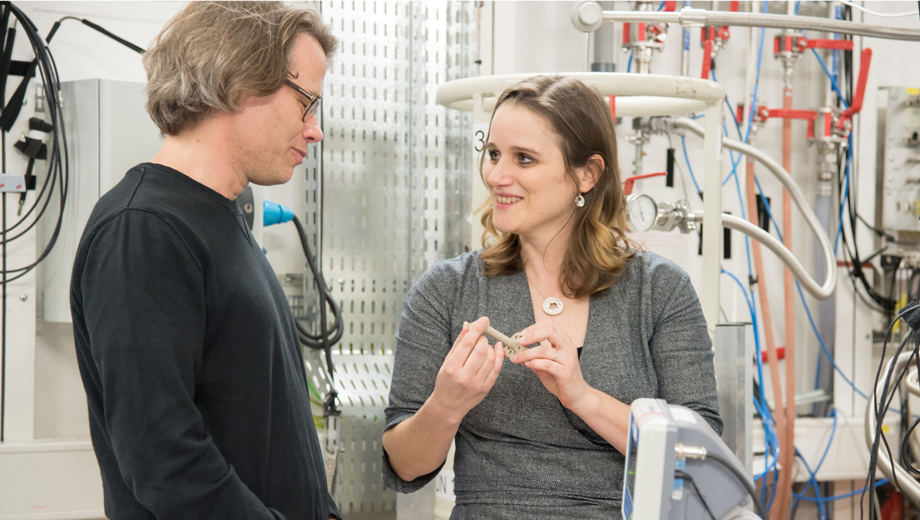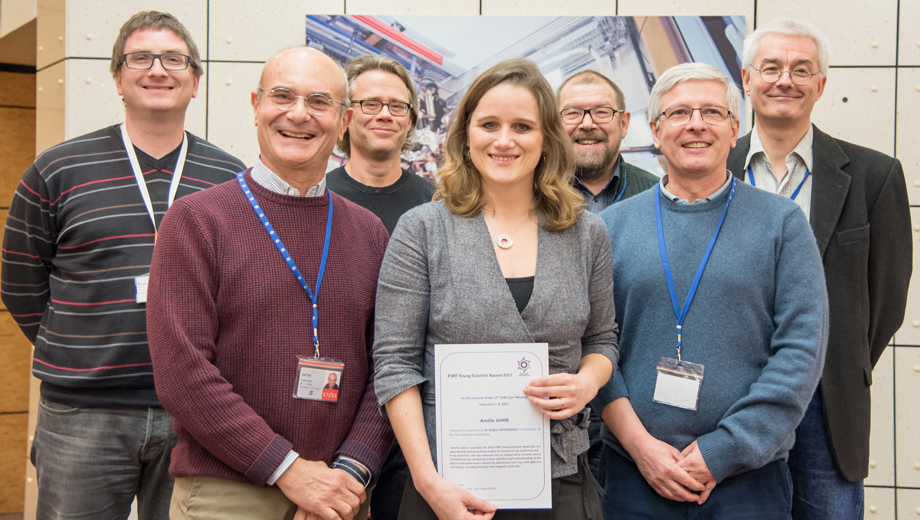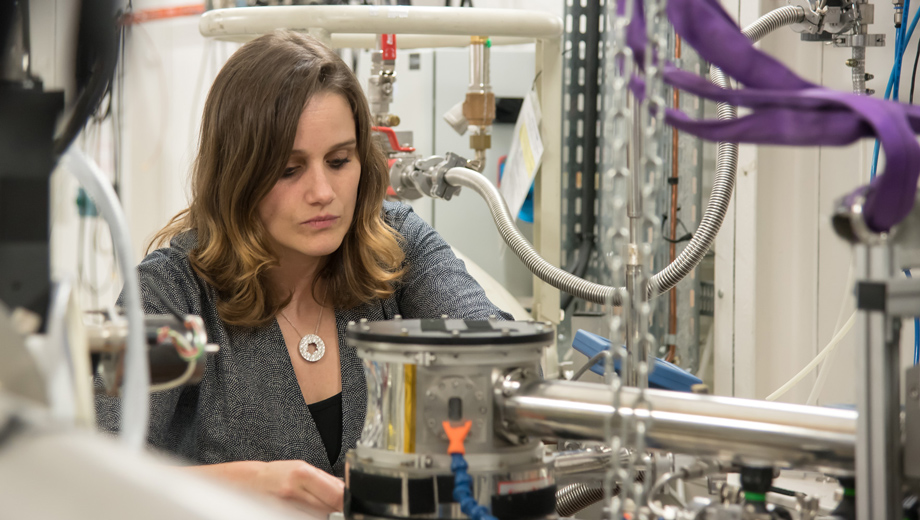- Home
- News
- General News
- Amélie Juhin wins...
Amélie Juhin wins Young Scientist Award 2017!
08-02-2017
The ESRF User Organisation has awarded the title of Young Scientist 2017 to Amélie Juhin for her experimental and theoretical studies of resonant X-ray scattering and X-ray dichroism. The prize was announced during the 27th ESRF annual User Meeting in Grenoble, on 7th February 2017.
Share
The Chairman of the jury, Dr Andrei Petoukhov, declared: “Amelie Juhin is awarded the 2017 ESRF Young Scientist Award for her experimental and theoretical studies of resonant X-ray scattering and X-ray dichroism. She has matured into an independent scientist whose contributions are marked by a deep and thorough understanding of the physics and mathematics behind the interactions of X-rays with different substances, including minerals and magnetic materials.”
“I am very honoured and pleased to be awarded the Young Scientist Award 2017”, said Amélie after being congratulated by members of the ESRF management and User Organisation during the award ceremony.
Amélie Juhin’s research is focused on probing the electronic and magnetic properties of nanoparticles and molecular magnets. She explores both the experimental and theoretical aspects of soft and hard X-ray spectroscopies with a particular focus on dichroisms (natural and magnetic). Amélie is currently working as a researcher at the Institute of Mineralogy, Physics of Materials and Cosmo-Chemistry (IMPMC - CNRS/Université Pierre et Marie Curie-Sorbonne-Universités/ Institut de Recherche pour le Développement/Museum National d'Histoire Naturelle). She has been a regular user of the ESRF’s ID12 and ID26 beamlines for more than 10 years.
ESRF triggers scientific vocation
Amélie didn’t always know that she wanted to be a scientist. In fact, after studying at the Ecole Normale Supérieure, she successfully qualified as associate professor in physical sciences and taught physics and French in Cambodia during a humanitarian mission in 2004. But her mind kept coming back to research and she started having doubts about a teaching career. She opted for a Masters in material sciences and nano-objects at the prestigious Pierre and Marie Curie University in Paris. After graduating top of her year, she pursued these studies with a PhD on the subject of electronic and structural properties of chrome impurities in crystals. The real trigger, however, to fully adhere to a scientific career came during her PhD work when she was sent to the ESRF to carry out some experiments. “It became obvious then that I wanted to be a scientist”, says Amélie. “For my PhD, I worked on the French CRG beamline, FAME, with Olivier Proux and Jean-Louis Hazemann, and I started to do experiments on ID26 beamline. I chose X-ray spectroscopy because it is a very diverse field of study, I can do different experiments and calculations. It’s very stimulating. I also find it fascinating that the measurement of X-ray dichroisms at the atomic scale allows to shed light on macroscopic properties such as colour and magnetism.”
 |
 |
|
Amélie on beamlines ID12 (left) with Andrei Rogalev, and on ID26 (right) with Pieter Glatzel. |
|
During a post-doctoral fellowship at the Debye Institute for Nanomaterials Science, at the University of Utrecht, in the Netherlands, Amélie strengthened her collaboration with ESRF scientists, Pieter Glatzel and Mauro Rovezzi. She developed a novel magnetic spectroscopy (photon-in, photon-out), the RIXS-MCD, and explored its complementarity to existing XMCD measurements such as those performed on ID12 with Andrei Rogalev and Fabrice Wilhelm For the magnetism community as well as for other scientific disciplines such as earth sciences, this new magnetic spectroscopy opens new paths of investigation. It has produced a number of original results which have been the subject of international publications.
For Prof. Philippe Sainctavit, Director of Research at CNRS, “Amélie was the tenacious driving force connecting international teams of experimentalists, theoreticians as well as chemists that made RIXS-MCD possible. She has a profound scientific maturity and, as an easy-going, young scientist, she brings her force, enthusiasm and scientific skills to colleagues, pulling everyone together to work on well-defined objectives.”
A succession of recognition and new projects in preparation
Amélie’s talent was recognised at an early stage and her list of awards and prizes is impressive. Not least, Amélie can boast first prize from the ESRF in the Best Poster Award at the 2010 annual User Meeting.
 |
Her contribution to the field of dichroism and X-ray resonant inelastic scattering has already earned recognition from her peers as demonstrated by the Farrel Lytle Young Scientist Award from the International X-ray Absorption Society that she received in 2015 and a Bronze Medal from the CNRS in 2016.
Amélie also has a busy life outside the laboratories, juggling a fulfilling family life with a successful career. “Now a mother of two young children, I try to combine both scientific and family lives, which are two exciting adventures!” Says Amélie, who also added: “Being a scientist has not meant I’ve had to put on hold starting a family.”
Amélie’s fruitful collaboration with the ESRF is not set to end any day soon. With the ESRF-EBS project, she has her sights set on new projects and the novel opportunities that will be made available with the greatly improved X-ray source. “I’m interested in materials whose magnetic properties can be switched through the application of pressure, and in textured magnetic liquids With ESRF-EBS, the gain in resolution and brilliance opens up very nice prospects in measuring in even better conditions than today.”
Read the press release in English (pdf).
Lisez le communiqué de presse en français (pdf).
About the Young Scientist Award
Each year since 1995, the Young Scientist Award (YSA) is presented to a scientist aged 37 or under in recognition of outstanding work carried out at the ESRF. The ESRF Users Organisation chooses a chairperson for the YSA. The chairperson then forms a selection committee composed of distinguished scientists whose expertise covers the most important areas of synchrotron science. The panel calls for nominations from institutes around the world and evaluates nominees on the basis of the following criteria:
• Significant and personal contribution to either a novel method or technique, or to the advancement of a particular field based on ESRF measurements
• Quality and quantity of publications, conference contributions and responsibilities
• Importance of the specific field for synchrotron science research
For the 2017 YSA, the jury was chaired by Dr Andrei Petoukhov, Associate Professor at the University of Utrecht in The Netherlands.
Who else has won the ESRF User Organisation Young Scientist Award?
Top image: Amélie Juhin at the award ceremony of the ESRF Young Scientist Award 2017. All photos©ESRF/C. Argoud





